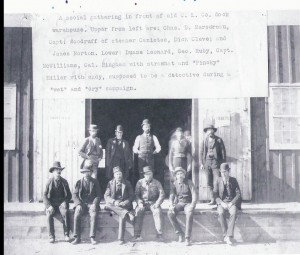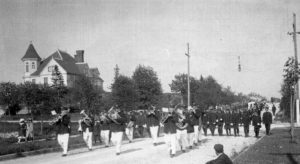The Flood Of 1920-Palm Sunday (March 28th, 1920) Manistique, MI-The most catastrophic event to occur in Manistique other than the fire of 1883 was the flood of 1920. Floodwaters began pouring over the flume walls in the early morning of Palm Sunday, March 28, 1920. The immediate cause of the flood was an ice jam on the Driggs River that backed the river up. When the jam broke, the water and logs in the river rushed into the Manistique River. Since the winter had an exceptional snowfall along with warmer than normal temperatures and several days of rain, the rivers draining into the Manistique River were already swollen. With the torrent of water, a west bank wall broke, causing water to rush over the flume walls and into the west side of Manistique all the way down Deer Street and Chippewa Avenue.
Tag Archives: Chicago Lumber Company
Southtown & Jamestown – Timber Boom Towns That Once Was
The earliest reference to South Manistique or “South-town” is from the early 1880’s. The town was developed around the Hall and Buell Lumber Company Mill. The following description of Southtown is from Earnest Williams: “Several houses in the town had four feet high fences around them to prevent the sand beach from blowing into the yards. All the streets were sand and grass was basically nonexistent.”
Hall and Buell lad lumber rights around Southtown and on Indian Lake. They cut the timber and floated it across Indian Lake to a “pull up” between Sunset and Harrison Beaches. From there it was loaded onto their own railroad and brought to the Southtown mill (The railroad crossed old U.S. 2 near the current location of WTIQ and the gas pipeline).
Memorial-Decoration Day History, Schoolcraft County
Memorial Day, originally called Decoration Day, is a day of remembrance for those who have died in our nation’s service. Memorial Day was officially proclaimed on 5 May 1868 by General John Logan, national commander of the Grand Army of the Republic, in his General Order No. 11, and was first observed on 30 May 1868, when flowers were placed on the graves of Union and Confederate soldiers at Arlington National Cemetery.
The above picture shows early Memorial Day parades in Manistique. The parades featured not only veterans from foreign wars but also the Civil War. Several bands were part of the parades along with the Woman’s Relief Corps, Red Cross, Catholic Benevolent Association, and Daughters of Veterans. Schoolchildren marched in formation with their teachers along with the 200-member Garden Club.
1890’s – The Flat Iron Block (Pearl Street, Water Street, and Maine Streets), and the Notorious Saloon Owner Daniel Heffron

The Chicago Lumber Company started around 1865 by two gentlemen by the names of Mr. Spinney and Mr. Boyd. Through the many years the Chicago Lumber Company owned most of Schoolcraft County and is responsible for the major development of Epsport (Manistique). During this time they started the Chicago Lumber Company Store. A social gathering in front of the old C. L. Co. dock warehouse. Upper from left are: Chas. B. Mersereau, Capt. Woodruff of Steamer Canisteo, Dick Cleve, and James Norton. Lower: Duane Leonard, Geo. Ruby, Capt. McWilliams, Cal Bingham with straw-hat, and “Pincky” Miller with cady, supposed to be a detective during a ‘wet” and “dry” campaign.
When the Chicago Lumber Company came to Manistique in 1872, they owned all of the town area except one residence. Their goal was to keep the town “dry”. Any property leased or later sold had a convenant attached to it saying that the premises could not manufacture, store or sell intoxicating liquors.
The residence referred to above was owned by Alex Richards. The location was bounded by Pearl Street, Water Street, and Maine Street, forming the a flatiron shape. The only liquor available was through whiskey boats that would anchor offshore. The whiskey sellers were finally arrested as a result of selling their goods to the Indians. In the 1880’s, Daniel Heffron from New York saw great opportunity in Manistique as a saloon-keeper. He found Richards, bought his property and built his saloon.

